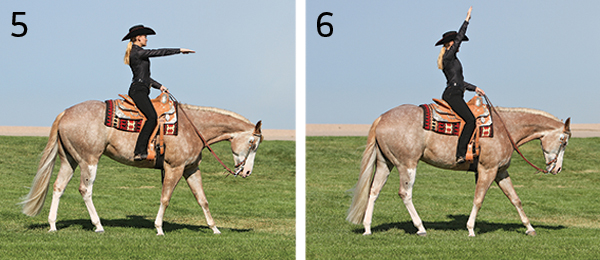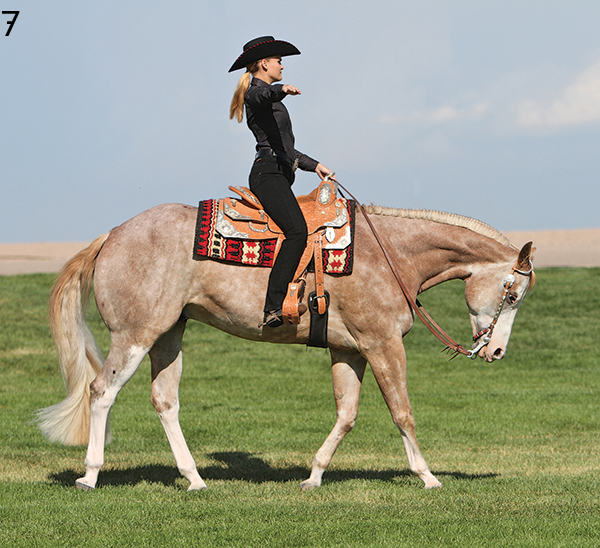You warm up your horse before a training session or a show class. You probably ease into your own workouts at the gym. But do you use warm-up exercises to get yourself into horsemanship position in the saddle?
Here, I’ll outline exercises my riders use to both build strength to improve their horsemanship position at home and to get themselves ready before a class. Hold the positions as long as you can, take a short break, and resume the exercise. Work through each gait, progressing from walk to jog to lope as you build strength and confidence.
1. Let’s begin by discussing what the optimal horsemanship position looks like. A strong leg is a necessity to maintain the position that aligns your ear, shoulder, hip, and heel. I prefer to see a rider sit on her seat bones and connect to the saddle with her thighs. From the knee down, contact between the rider’s calf muscles and the horse keeps her legs quiet. The rider here shows a strong leg in a good position. A weak leg moves forward or backward, out of alignment. The rider must compensate for that misalignment by hunching forward or leaning backward, which puts her off balance and out of position.

2. It might sound easy, but the strength required to stand in your stirrups without tipping forward or backward will test you. Stretch down through your heels, maintain the line from ear to shoulder to hip to heel as best you can. Begin with a few strides at a time, and work up to a few laps around the arena. When you return to the seated position, don’t slack your body’s alignment; stay in position even when you’re taking a break. Ultimate challenge: Drop your stirrups and “stand” in your saddle. Use your inner thighs to elevate your seat from the saddle, while maintaining your body and leg alignment.

3. The two-point position isn’t just for going over jumps. You can use it to build leg strength in a Western saddle, too. Tip your body slightly forward at the waist, lift your seat from the saddle, and keep your legs in alignment, from hip to heel. It’s easy to push your legs behind you in this position. Work to hold your leg underneath your body, in alignment with your ear, shoulder, and hip. Keep your leg quiet (minimize movement) as you travel along. Ultimate challenge: Drop your stirrups, and assume a two-point position.
4. You probably already think about stretching your heels down as far as you can (4a) to strengthen your leg and show good heel position when you compete. Keep that up, and work on it at all gaits. But also add toe-down exercises (4b) to keep your calf muscle flexible. Pointing down also changes your balance as you walk, jog, and lope, which gives your legs another challenge. Use care when practicing these exercises with spurs so you don’t inadvertently jab your horse with a rowel, especially in the toe-down position. Quick-comfort tip: When you take a break after deep-heel and toe-down exercises, roll your ankles around to help loosen them and prepare for another round.

5. Arm exercises further test your balance and leg strength by offsetting your balance just enough that you have to work harder to keep your legs in place. Begin with your non-rein hand (this rider’s right hand), and then swap your reins to the other side. Work both arms to keep your balance and strength even. Begin with one arm straight out in front of you. Don’t sacrifice your leg position; maintain the straight line discussed in Photo 1. Work at all gaits, and add time with each attempt to build strength.

6. Next, put your arm straight up in the air. Stretch your fingers to the sky, but don’t elevate your lifted arm’s shoulder higher than your other shoulder. Keep your shoulders square and balanced to avoid developing bad habits in your upper-body posture while you work on building leg strength.
7. Finally, stretch your arm out perpendicular to your body. Keep your shoulders square, and don’t be tempted to get lazy and let your arm creep up or down! Keep it straight out from your shoulder. Ultimate challenge: Drop the opposite stirrup of the arm you have extended forward, up, or to the side to further challenge your balance and leg strength. n

Brian Henry owns and operates Limelite Show Horses out of Fruita, Colorado, with John Zeldenthuis. Henry, an APHA Professional Horseman, coaches youth and amateur riders for all-around competition in Paint and Pinto breed shows, as well as training and exhibiting in open classes within those breeds. His successes include 36 total world and reserve world titles in classes varying from hunter under saddle to trail to leadline, a class his daughter competes in on the horse shown in this lesson. Learn more at limeliteshowhorses.com.






